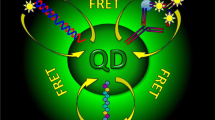Abstract
In this paper, we present the optical properties and the platforms on fluorescent quantum dots for biological labeling, biomedical engineering and biosensor in molecular imaging. Quantum dots possess several properties that make them very attractive for fluorescent tagging: broad excitation spectrum, narrow emission spectrum, precise tunability of their emission peak, longer fluorescence lifetime than organic fluorophores and negligible photobleaching. We describe how to take such advantages of quantum dots to develop the technology and employ it to build assay platforms. Finally, ultrasensitivity, multicolor, and multiplexing of the technology of semiconductor quantum dots open up promising and interesting possibilities for bioassay platform.
Similar content being viewed by others
References
J. R. Taylor, M. M. Fang, and S. Nie (2000). Probing specific sequences on single DNA molecules with bioconjugated fluorescent nanoparticles. Anal. Chem. 72, 1979–1986.
J. J. Storhoff, R. Elghanian, R. Music, C. A. Mirkin, and R. L. Letsinger (1998) One-pot colorimetric differentiation of polynucleotides with single base imperfections using gold nanoparticle probes. J. Am. Chem. Soc. 120, 1959–1964.
R. A. Reynolds, C. A. Mikin, and R. L. Letsinger (2000). Homogeneous, nanoparticle-based quantitative colorimetric detection of oligonucleotides. J. Am. Chem. Soc. 122, 3795–3796.
M. Bruchez Jr, M. Moronne, P. Gin, S. Weiss, and A. P. Alivisatos (1998). Semiconductor nanocrystals as fluorescent biological labels. Science 281, 2013–2015.
W. W. C. Chan and S. M. Nie (1998). Quantum dot bioconjugates for ultrasensitive nonisotopic detection. Science 281, 2016–2018.
S. Empedocles and M. G. Bawendi(1999). Spectroscopy of single CdSe nanocrystallites. Acc. Chem. Res. 32, 389–396
J. R. Heath (1995). The chemistry of size and order on a nanometer scale. Science 270, 1315–1316.
M. Nirmal, B. O. Dabbousi, M. G. Bawendi, J. J. Macklin, J. K. Trautman, T. D. Harris, and L. E. Brus (1996). Fluorescence intermittency in single cadmium selenide nanocrystals. Nature 383, 802.
M. G. Bawendi, P. J. Carroll, W. L. Wilson, and L. E. Brus (1992). Luminescence properties of CdSe quantum crystallites: Resonance between interior and surface localized states. J. Chem. Phys. 96, 946–954.
M. G. Bawendi, M. L. Steigerwald, and L. E. Brus (1990). The quantum mechanics of larger semiconductor clusters (“quantum dots”). Annu. Rev. Phys. Chem. 41, 477–496.
M. Nirmal and L. Brus (1999). Luminescence photophysics in semiconductor nanocrystals. Acc. Chem. Res. 32, 407–414.
J. E. B. Katari, V. L. Colvin, and A. P. Alivisatos (1994). X-ray photoelectron spectroscopy of CdSe nanocrystals with applications to studies of the nanocrystal surface. J. Phys. Chem. 98, 4109–4117
J.Tittel, W. Gohde, F. Koberling, T. Basche, A. Kornowski, H. Weller, and A. Eychmuller (1997). Fluorescence spectroscopy on single CdS nanocrystals. J. Phys. Chem. B 101, 3013–3016.
F. V. Mikulec, M. Kuno, M. Bennati, D. A. Hall, R. G. Griffin, and M. G. Bawendi (2000). Organometallic synthesis and spectroscopic characterization of manganese-doped CdSe nanocrystals. J. Am. Soc. 122, 2532–2540.
Y. Wang and N. Herron (1991). Nanometer-sized semiconductor clusters: Materials synthesis, quantum size effects, and photophysical properties. J. Phys. Chem. 95, 525–532.
A. P. Alivisatos (1996). Semiconductor clusters, nanocrystals, and quantum dots. Science 271, 933–937.
A. Henglein (1989). Small-particle research: Physicochemical properties of extremely small colloidal metal and semiconductor particles. Chem. Rev. 89, 1861–1873.
X. G. Peng, J. Wickham, and A. P. Alivisatos (1998). Kinetics of II–VI and III–V colloidal semiconductor nanocrystal growth: “Focusing” of size distributions. J. Am. Chem. Soc. 120, 5343–5344.
A. P. Alivisatos (1996). Perspectives on the physical chemistry of semiconductor nanocrystals. J. Phys. Chem. 100, 13226–13239.
N. Gaponik, I. L. Radtchenko, G. B. Sukhorukov, H. Weller, A. L. Rogach (2002). Toward encoding combinatorial libraries: Charge-driven microencapsulation of semiconductor nanocrystals luminescing in the visible and near IR. Adv. Mat. 14, 879.
U. Banin and O. Millo (2003). Tunneling and optical sepectroscopy of semiconductor nanocrystals. Ann. Rev. Phys. Chem. 54, 465–492.
R. E. Bailey and S. Nie (2003). Alloyed semiconductor quantum dots: Tuning the optical properties without changing the particle size. J. Am. Chem. Soc. 125(23), 7100–7106.
X. Gao, Y. Cui, R. M. Levenson, L. W. K. Chung, and S. Nie (2004). In vivo cancer targeting and imaging with semiconductor quantum dots. Nat. Biotech. 22, 969–976.
H. Mattoussi, J. M. Mauro, E. R. Goldman, G. P. Anderson, V. C. Sundar, F. V. Mikulec, and M. G. Bawendi (2000). Self-assembly of CdSe–ZnS quantum dots bioconjugates using an engineered recombinant protein. J. Am. Chem. Soc. 122, 12142–12150.
L. C. Mattheakis, J. M. Dias, Y.-J. Choi, J. Gong, M. P. Bruchez, J. Liu, and E. Wang (2004). Optical coding of mammalian cells using semiconductor quantum dots. Anal. Biochem. 327, 200–208.
M. Y. Han, X. Gao, J. Z. Su, and S. M. Nie (2001). Quantum-dot-tagged microbeads for multiplexed optical coding of biomolecules. Nat. Biotech. 19, 631–635.
Author information
Authors and Affiliations
Corresponding author
Rights and permissions
About this article
Cite this article
Liu, T., Liu, B., Zhang, H. et al. The Fluorescence Bioassay Platforms on Quantum Dots Nanoparticles. J Fluoresc 15, 729–733 (2005). https://doi.org/10.1007/s10895-005-2980-5
Received:
Accepted:
Issue Date:
DOI: https://doi.org/10.1007/s10895-005-2980-5




